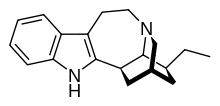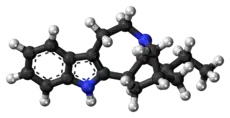Ibogamine
 | |
 | |
| Clinical data | |
|---|---|
| ATC code |
|
| Identifiers | |
IUPAC name
| |
| CAS Number | |
| PubChem CID | |
| ChemSpider | |
| ChEBI | |
| CompTox Dashboard (EPA) | |
| Chemical and physical data | |
| Formula | C19H24N2 |
| Molar mass | 280.415 g·mol−1 |
| 3D model (JSmol) | |
SMILES
| |
InChI
| |
| | |
Ibogamine is an anti-convulsant, anti-addictive, CNS stimulant alkaloid found in Tabernanthe iboga and Crepe Jasmine (Tabernaemontana divaricata).[1][2][3] Basic research related to how addiction affects the brain has used this chemical.[4]
Ibogamine persistently reduced the self-administration of cocaine and morphine in rats.[5] The same study found that ibogamine (40 mg/kg) and coronaridine (40 mg/kg) did not produce "any tremor effects in rats that differ significantly from saline control". While the related alkaloids ibogaine (20–40 mg/kg), harmaline (10–40 mg/kg) and desethylcoronaridine (10–40 mg/kg) were "obviously tremorgenic".[5]
Chemistry
Synthesis
Ibogamine can be prepared from one-step demethoxycarbonylation process through coronaridine.[6]
Pharmacology
Like ibogaine, it has seems to have similar pharmacology. It has effects on KOR,[7] NMDAR, nAChR[8] and serotonin sites.[9] It also inhibits acetycholinestearase and butrylcholinestearase[10]
See also
- Coronaridine
- Ibogaine
- Ibogaline
- Tabernanthine
- Voacangine
- Harmaline
References
- ↑ Bartlett, M. F.; Dickel, D. F.; Taylor, W. I. (1958). "The Alkaloids of Tabernanthe iboga. Part IV.1 The Structures of Ibogamine, Ibogaine, Tabernanthine and Voacangine". Journal of the American Chemical Society. 80 (1): 126–136. doi:10.1021/ja01534a036.
- ↑ Kuehne, Martin E.; Reider, Paul J. (1985). "A synthesis of ibogamine". The Journal of Organic Chemistry. 50 (9): 1464–1467. doi:10.1021/jo00209a020.
- ↑ Ankita Kulshreshtha, Jyoti Saxena. "Alkaloids and Non Alkaloids of Tabernaemontana divaricata" (PDF). Archived from the original (PDF) on 25 June 2020.
{{cite journal}}: Cite journal requires|journal=(help)CS1 maint: uses authors parameter (link) - ↑ Levi MS, Borne RF (October 2002). "A review of chemical agents in the pharmacotherapy of addiction". Curr. Med. Chem. 9 (20): 1807–18. doi:10.2174/0929867023368980. PMID 12369879.
- 1 2 Glick SD, Kuehne ME, Raucci J, Wilson TE, Larson D, Keller RW Jr, Carlson JN (September 1994). "Effects of iboga alkaloids on morphine and cocaine self-administration in rats: relationship to tremorigenic effects and to effects on dopamine release in nucleus accumbens and striatum". Brain Res. 657 (1–2): 14–22. doi:10.1016/0006-8993(94)90948-2. PMID 7820611. S2CID 1940631.
- ↑ Krengel F, Mijangos MV, Reyes-Lezama M, Reyes-Chilpa R (July 2019). "Extraction and Conversion Studies of the Antiaddictive Alkaloids Coronaridine, Ibogamine, Voacangine, and Ibogaine from Two Mexican Tabernaemontana Species (Apocynaceae)". Chemistry & Biodiversity. 16 (7): e1900175. doi:10.1002/cbdv.201900175. PMID 31095891. S2CID 157058497.
- ↑ Deecher, Darlene C.; Teitler, Milton; Soderlund, David M.; Bornmann, William G.; Kuehne, Martin E.; Glick, Stanley D. (1992). "Mechanisms of action of ibogaine and harmaline congeners based on radioligand binding studies". Brain Research. 571 (2): 242–247. doi:10.1016/0006-8993(92)90661-R. ISSN 0006-8993. PMID 1377086. S2CID 17159661.
- ↑ Arias HR, Targowska-Duda KM, Feuerbach D, Jozwiak K (August 2015). "Coronaridine congeners inhibit human α3β4 nicotinic acetylcholine receptors by interacting with luminal and non-luminal sites". The International Journal of Biochemistry & Cell Biology. 65: 81–90. doi:10.1016/j.biocel.2015.05.015. PMID 26022277.
- ↑ "Ethnobotany & ethnopharmacology of Tabernaemontana divaricata. - Free Online Library".
- ↑ "Annals of the Brazilian Academy of Sciences" (PDF).